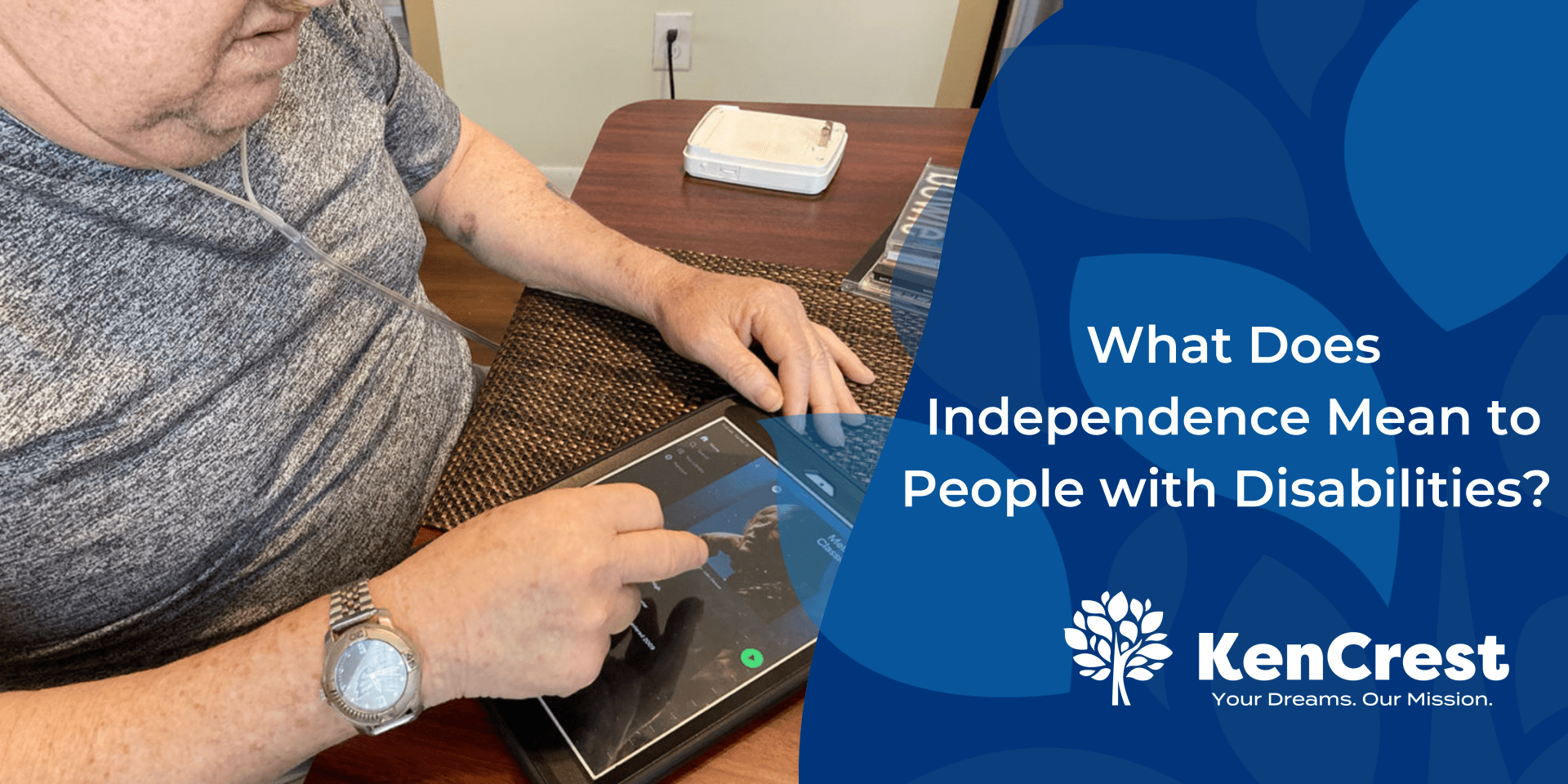What Does Independence Mean to People with Disabilities?

KenCrest’s Enabling Technologies program helps those with disabilities gain independence through different devices.
By Sydney Kerelo
For people with intellectual and developmental disabilities, achieving complete independence is a feat that seems nearly impossible. Many disabled people have not had full autonomy over their own lives, and oftentimes have family members, medical, and care staff influencing or making decisions for them.
Enabling Technology, often known as Assistive Technology, assists people with disabilities to gain independence in their day-to-day lives through devices like sensors, adapted tools, and even communication supports.
With the DSP (Direct Support Professional) Crisis and Workforce Crisis wreaking havoc throughout the United States, many individuals with disabilities are losing the additional staff support they are used to getting. That’s when Enabling Technologies can step in and help alleviate the need for constant direct supports.
According to Disability Scoop, “the program ethos to help those with disabilities live a more independent life and become less reliant on in-person help took on more meaning as the pandemic hit, and having helpers come in and out of the home became a risk. Two-way audio and video communication implemented by Enabling Technology lets caregivers check in remotely.”
For example, George and Louise, two long-time residents supported through KenCrest’s Community Living program; felt unseen and unsure of how to support themselves independently.
“They’ve been in our system for a long time, and they’ve relied on people for a long time,” says Joe McGuire, the Assistive Technology Specialist. “They’re interested in technology but tend to be hesitant about it.”
RELATED: How Enabling Technologies Help This Pennsylvania Couple
Using enabling tech had never been a part of their experience, and they needed a more comprehensive explanation of what tools and devices were available to them.
According to Disabled Living, “Over the years, companies have worked harder than ever to ensure that anyone can use their products. In the past, the elderly and disabled have had reason to believe that Technology was out of their reach. For some, it was because there weren’t features that could assist them. For others, it was because there was a lack of understanding as to how the use of Technology could benefit them. Fortunately, there are now some admirable pieces of Technology for disabled people that are easier to use than ever.”
Unfortunately, the IDD population is woefully underrepresented, and they don’t know how to access and use these devices. McGuire has seen many people with disabilities become frustrated with their lack of knowledge and understanding of technological devices.


George and Louise with their newest pieces of Enabling Technologies. // Photos courtesy of Joe McGuire.
“My main concern when helping people use technology is that I want to make sure each person I work with sees its value,” says McGuire. “Sometimes that takes an afternoon or a year. It depends on the person, but we will continue to work with them until they don’t need us anymore.”
For the past year, McGuire has worked with George and Louise to help them become acclimated to using tech support. Now, the couple is asking McGuire for more devices to increase their independence.
McGuire says that whenever he shows up at their house, they have a list of items for him to look at.
George and Louise aren’t the only people with disabilities utilizing KenCrest’s Enabling Technology program. Pete is another individual living on his own through our Supported Independent Living program who uses Technology daily.
For more than 20 years, he has lived on his own apartment and receives 19 hours of support from his Community Connection Coach, Annette Hanks. When COVID hit, Pete could not connect with his community consistently, so Annette began looking at different technologies to use in his home. One device he purchased was an upgraded computer with speakers and a camera so he could participate in virtual meetings and take online classes.
RELATED: The Office of Developmental Programs Showcases Resident’s Tech
Pete’s most recent engagement with the Enabling Technology department was when he upgraded his power chair.
“He’s had a power chair for a long time; I helped him get his first one and then his latest one,” says Hanks. “With each new chair, there’s increasing technology, now his arm can swing around, and his joystick can move so he can get closer to the table.”

Enabling Technology is designed to support the work done by Direct Support Professionals and help improve the lives of people with disabilities. These technologies aren’t about replacing staff but about enhancing and empower clients to live the life, they envision for themselves.
“Technology, natural supports, and paid staff can work hand-in-hand to make that happen,” writes Debra Payne on the Tennessee Works website.
Are you interested in learning more about KenCrest’s Enabling Technology program and how it can assist the people you support?
References:
Herner, Hannah (2022, January 25). How Technology Can Help People With Disabilities Become More Independent. Disability Scoop. https://www.disabilityscoop.com/2022/01/25/how-technology-can-help-people-with-disabilities-become-more-independent/29670/
Payne, Debra (2017, September 27). What is “Enabling Technology?” How Can it Help People with Disabilities? Tennessee Works. https://www.tennesseeworks.org/what-is-enabling-technology-how-can-it-help-people-with-disabilities/
